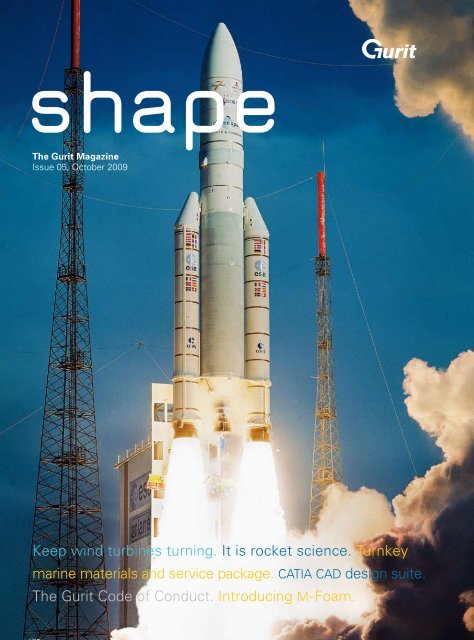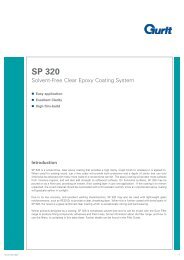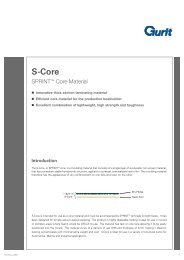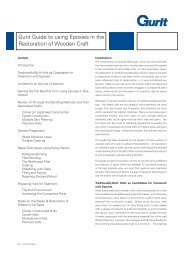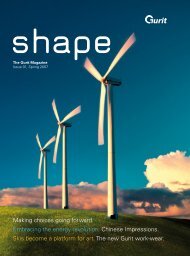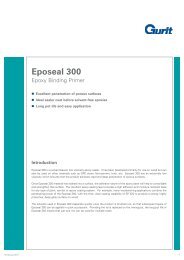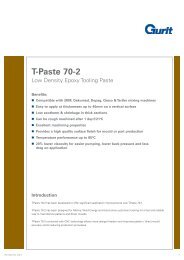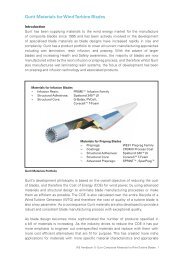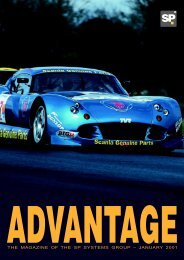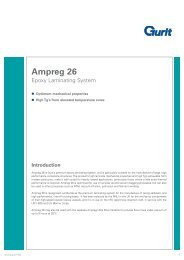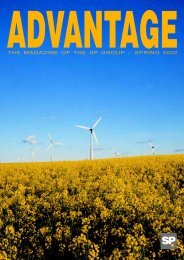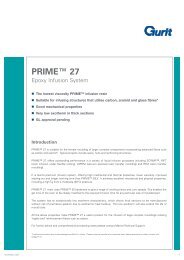Shape - Gurit
Shape - Gurit
Shape - Gurit
You also want an ePaper? Increase the reach of your titles
YUMPU automatically turns print PDFs into web optimized ePapers that Google loves.
shape<br />
The <strong>Gurit</strong> Magazine<br />
Issue 05, October 2009<br />
Keep wind turbines turning. It is rocket science. Turnkey<br />
marine materials and service package. c at i a c a d design suite.<br />
The <strong>Gurit</strong> Code of Conduct. Introducing m-Foam.
Dear Reader,<br />
In the first half of 2009, <strong>Gurit</strong> achieved its target of maintaining the<br />
operational performance level of 2008, despite a sales decline in our<br />
target markets of some 12% at constant currency translation rates.<br />
Ongoing operational improvements, further progress in Group-wide<br />
purchasing, together with rapidly introduced and often painful costsaving<br />
measures compensated the negative effects from lower<br />
sales and thus lower capacity utilization. <strong>Gurit</strong> closed the period with<br />
a strong balance sheet and a remarkable net cash position. Our<br />
healthy financial status gives us good reason to look ahead with confidence,<br />
although we expect markets only to broadly recover next<br />
year.<br />
In troubled times like these, it is very important to stay focused on<br />
the longer-term perspectives. <strong>Gurit</strong> pushes firmly ahead with its<br />
strategy implementation. While our global capacities are not fully<br />
loaded, we concentrate on even further improving our equipment,<br />
on training our colleagues, on exploring new market opportunities.<br />
Doing so, we build a solid foundation for future success.<br />
We enhance our positions in all our target markets by providing our<br />
customers with tailor-made solutions, expanding our role as a leading<br />
materials and technology provider in advanced composites and<br />
by expanding our addressable markets. In this edition of s h a p e, we<br />
invite you to discover how <strong>Gurit</strong> contributes to bringing satellites<br />
safely into space, to making passenger ferries more fuel efficient, to<br />
helping expand the life span of wind energy generators and to speed<br />
up automotive design projects.<br />
With our materials and technologies, <strong>Gurit</strong> contributes to making our<br />
one world more sustainable. Doing business globally, we also acknowledge<br />
the importance of adhering world-wide to high standards,<br />
be it in terms of environment, health and safety, in terms of emloyer<br />
relations, or with respect to our business conduct. Our efforts are<br />
widely recognized wherever we do business: <strong>Gurit</strong> (Tianjin) – for instance<br />
– was just presented with a prize for special social achievements<br />
in the Tianjin Economic Development Area, t e d a , in China.<br />
The various high standards <strong>Gurit</strong> sites and <strong>Gurit</strong> employees have<br />
been traditionally complying with locally have now been integrated<br />
into our <strong>Gurit</strong> Code of Conduct also presented to you in this edition<br />
of s h a p e and on the <strong>Gurit</strong> website www.gurit.com.<br />
Yours sincerely<br />
Rudolf Hadorn, c e o<br />
Contents<br />
Corporate News 04 <strong>Gurit</strong> (Tianjin) recognized for outstanding employee<br />
relations 04 Governor of the Bank of England Visits <strong>Gurit</strong> (u k )<br />
04 <strong>Gurit</strong> (Tianjin) receives i s o 14001 certification and is rec-<br />
ognized for outstanding employee relations 10 An interview with<br />
Robin Price, Chief Purchasing Officer 17 Sticking to strategic<br />
priorities Markets 06 Six hours – and the new bridge was there<br />
08 It is rocket science 12 Crossing over to Copenhagen’s Opera<br />
now saves 50% energy 14 Keep them turning 20 Turn-key materi-<br />
als and services package TechTalk 11 c at i a reduces design and<br />
development time 18 M-Foam – the foam for all marine applica-<br />
tions Being <strong>Gurit</strong> 05 Automotive Press Tour 05 <strong>Gurit</strong> congratulates<br />
m b p v 22 Our Website in Chinese 22 Get on your bikes 23 The <strong>Gurit</strong><br />
Code of Conduct<br />
Imprint: <strong>Gurit</strong> Holding AG, Group Communications<br />
Editor in Chief: Bernhard Schweizer<br />
Thank you for your feedback at s h a p e@gurit.com<br />
Pictures courtesy of: Ruag Space/ESA (1, 8, 9), Aston Martin (5, 11)<br />
Rail Media Group/Birse Rail (6), www.schmidtaps.com (12/13 landscape), e w e a / Vestas (14, 15, 16)<br />
Nautor/Swan (20), istockphoto (22, 23) and Group company photo archives<br />
Concept and Design: <strong>Gurit</strong> and Eclat AG, Erlenbach<br />
Cover: <strong>Gurit</strong> supplies prepreg materials for the payload fairings of the Ariane 5 rockets.<br />
Inside Cover: Windwand, designed by Ron Arad, is made from <strong>Gurit</strong> carbon fibre prepreg.<br />
This 50 metre needle pierces the sky above Canary Wharf in London.<br />
The <strong>Gurit</strong> Magazine 05_2009 03<br />
Wind energy Transportation Marine
Corporate News<br />
GuriT (TiaNjiN) reCoGNized for<br />
ouTsTaNdiNG eMployee relaTioNs<br />
The Tianjin Economic Development Area (t e d a ) is the most successful<br />
inward investment region in China, attracting billions of dollars of<br />
foreign investment over the last 20 years. With over 4000 companies<br />
present, t e d a boasts 76 subsidiaries of «Fortune 500» companies. To<br />
celebrate the achievements of the Foreign Invested Companies,<br />
t e d a honoured 20 outstanding General Managers who they felt had<br />
contributed to the local society and business success of t e d a . Phil<br />
Harnett, General Manager of <strong>Gurit</strong> (Tianjin), received one of the 20<br />
prestigious awards. The jury not only focused on the financial success<br />
of the companies but also on how they contribute to society. Training<br />
and staff development, labour relations, working atmosphere or staff<br />
turnover were important criteria as well as compliance with local environment,<br />
health and safety laws and policies or the general factory<br />
safety and cleanliness.<br />
<strong>Gurit</strong> achieved remarkable rankings in a number of categories. For<br />
instance, <strong>Gurit</strong> (Tianjin) is reported to have the lowest personnel turnover<br />
of all factories in the area. In addition, <strong>Gurit</strong>’s outstanding record<br />
of having had only three minor accidents since its opening two years<br />
ago was also mentioned. Last but not least, it was noted with thanks<br />
that the staff of <strong>Gurit</strong> (Tianjin) generously donated more than 20,000<br />
r m b to the Sichuan earthquake fund. Our picture shows Phil Harnett<br />
receiving the award from Mr Li Yong, the Secretary of Party Leadership<br />
Group.<br />
GoverNor of The BaNk of eNGlaNd<br />
visiTs GuriT (uk)<br />
<strong>Gurit</strong> (u k ) had the pleasure of welcoming Mervyn King, Governor of<br />
the Bank of England, to its premises on June 19, 2009. The Governor<br />
visited <strong>Gurit</strong> and other companies on the Isle of Wight to get a firsthand<br />
picture of the economic environment within the region. As Governor<br />
of the Bank of England, Mervyn Allister King holds the most<br />
senior position in the Bank of England. The Governor is also Chairman<br />
of the Monetary Policy Committee, with a major role in guiding<br />
the British economic and monetary policy, and is therefore one of<br />
the most important public officials in the United Kingdom. He accompanied<br />
the Bank’s central Southern England agent, Chris Piper, on his<br />
visit to <strong>Gurit</strong> (u k ), as well as other businesses on the Isle of Wight.<br />
Feedback received from these businesses is used by the Bank to<br />
compile a picture of the economic environment and the issues being<br />
faced within the region. At <strong>Gurit</strong>, the Governor was received by<br />
Graham Harvey, General Manager Marine and Managing Director of<br />
<strong>Gurit</strong> (u k ), and Mary Spradbery, Head of Finance at <strong>Gurit</strong> (u k ), and<br />
was treated to a tour of the <strong>Gurit</strong> premises and the operations factory<br />
before meeting management to be updated on current market<br />
conditions.<br />
GuriT (TiaNjiN) reCeives<br />
iso 14001 CerTifiCaTioN<br />
<strong>Gurit</strong> (Tianjin) is pleased to announce that the company has been<br />
awarded the iso 14001 certification for its Environmental Management<br />
Systems. Human Resources Manager Christina Yin (in red<br />
blouse) who is also responsible for e h&s at <strong>Gurit</strong> (Tianjin) had coordinated<br />
the process for the independent audit made by Det Norske<br />
Veritas.<br />
Being <strong>Gurit</strong><br />
auToMoTive press Tour<br />
In late August, <strong>Gurit</strong> (u k ) had the pleasure of welcoming a group of<br />
VIP automotive journalists including Autocar and Car Design News to<br />
the new u k based Automotive facility. The two-day press event was<br />
arranged to launch the facility to <strong>Gurit</strong>’s target automotive and trade<br />
press and highlight the benefits of carbon composites in automotive<br />
design. The first day of the tour started with an introduction and tour<br />
of the <strong>Gurit</strong> (u k ) plant followed by presentations and interactive<br />
displays on the benefits of composites in car design given by both<br />
Martin Starkey, Managing Director Automotive, and the esteemed<br />
Automotive Designer, Peter Stevens. The journalists were then treated<br />
to a sail across the Solent from Yarmouth to Lymington in a Jeanneau<br />
45.2, followed by an intimate dinner party hosted by <strong>Gurit</strong> and<br />
Peter Stevens in the Stanwell House hotel, Lymington. The agenda<br />
continued the following day with a v i p tour around the Aston Martin<br />
plant in Gaydon in which the guests viewed how the new technology<br />
carbon body panels are fitted to the d b s Coupé and d b s Volante –<br />
the two models that feature <strong>Gurit</strong> made Class a carbon car body<br />
parts – and how they integrate alongside more established body technologies,<br />
such as aluminium.<br />
MBpv suCCessful oN iTs reCord huNT<br />
s p, the marine business of <strong>Gurit</strong>, are proud to be part of the composite<br />
engineering team for the Maxi Trimaran Banque Populaire v<br />
(m b p v ), the 40 metre by 23 metre boat. On Sunday August 2, 2009,<br />
this boat – engineered for a record hunt/s h a p e Nr 4 – beat the historic<br />
west to east transatlantic record and secured the fastest<br />
24 hour run time, breaking the previous record by a staggering 12<br />
hours, 32 minutes and 6 seconds. Congratulations to Skipper Pascal<br />
Bidégorry and his sailing team, the architects v p l p and all the m b p v<br />
team. During the race, which began in New York on July, 30, 2009 at<br />
22h 47m and which concluded at Lizard Point off Cornwall, at 16h<br />
13mn 13s (French time) on August 2, skipper Pascal Bidégorry and<br />
his eleven person crew on board the m b p v also set a new 24hr<br />
record of travelling 908 miles at an impressive average speed of 37,8<br />
knots. Franck Cammas on Groupama 3 also set off to beat his own<br />
record just under 3 hours earlier, but then finishing eleven minutes<br />
after m b p v . From the outset of the boat’s development, the worldleading<br />
French multihull naval architects v p l p, who designed m b p v ,<br />
had ambitions for the boat to become the largest and fastest offshore<br />
sailing trimaran on the water. They aimed to challenge and<br />
beat all existing offshore sailing records, and utilized advanced composite<br />
materials and the 20 years of experience of s p in conjunction<br />
with h d s to develop the boat structure which would go onto achieve<br />
this in triumphant style.<br />
<strong>Gurit</strong> (u k ) empfing im Sommer den Governor der Bank of England und<br />
organisierte eine Tour für die Automobilpresse. <strong>Gurit</strong> (Tianjin) ist nun i s o<br />
14001-zertifiziert und wurde unlängst als beispielhafter Arbeitgeber<br />
ausgezeichnet. 今年夏天,固瑞特(英国)接待了英国银行行长的来<br />
访,并且成功地举办了一场汽车之旅活动。随着自行车价格的降<br />
低,固瑞特英国公司越来越多的同事选择骑自行车上下班。固瑞特<br />
天津)已通过ISO14001的认证,并且最近被评为优秀经理人。<br />
04 shape<br />
The <strong>Gurit</strong> Magazine 05_2009 05
Modular bridges<br />
Six hourS – and the<br />
new bridge waS there<br />
In nur sechs Stunden wurden vier aus <strong>Gurit</strong> Prepregs<br />
gefertigen Elemente an Ort und Stelle zu einer praktisch<br />
wartungsfreien Fussgängerbrücke zusammengefügt.<br />
桥 四个用固瑞特预浸料制造的可随时安装的部<br />
件已放置到位,只用了不到六个小时,便安装组<br />
成了免维护的人形桥。<br />
The Bradkirk footbridge over the main Preston-Blackpool railway tracks in Britain was<br />
built by a m Structures Ltd on the Isle of Wight using <strong>Gurit</strong>’s composite technology<br />
and materials. The four ready-to-install parts of the bridge were craned into place and<br />
up for years of minimum maintenance service in less than six hours.<br />
Structural composites are increasingly used in construction. They offer<br />
light-weight, corrosion-free and easy to install solutions using offsite<br />
engineered and fabricated elements. Network Rail, the company<br />
owning and operating Britain’s rail infrastructure, was looking for the<br />
most cost-effective way to replace a life-expired steel bridge. The old<br />
structure was comprised of two steel latticework spans resting on<br />
three brick piers.<br />
developiNG a sTaNdardised BridGe desiGN<br />
Network Rail was keen to trial moulded composite technology to develop<br />
a standardised bridge design where the mould could be used<br />
for multiple spans. At first, the plug was produced. This is a singleuse<br />
timber former which serves to form the final shape of the mould.<br />
The mould is then made from glass fibre reinforced epoxy resin and<br />
can be used up to 500 times.<br />
effiCieNT MaNufaCTuriNG TeChNoloGy<br />
The bridge elements – two 12 metre spans and two flights of steps<br />
– were manufactured by a m Structures Ltd on the Isle of Wight.<br />
Each span is a fully moulded composite monocoque sandwich structure<br />
using <strong>Gurit</strong>’s patented s p r i n t ® epoxy technology materials above<br />
and below a structural foam core. s p r i n t ® prepregs consist of a fibre<br />
reinforcement layer on either side of a precast resin film with a light<br />
tack film on one face. Unlike conventional prepregs they remain dry<br />
and offer easy handling until cured. This also gives s p r i n t ® materials<br />
an outstanding breathability and results in autoclave quality laminate<br />
without the expense of using an autoclave.<br />
virTually MaiNTeNaNCe-free sTruCTure<br />
The bridge could have been painted using standard epoxy or polyurethane<br />
paint, yet Network Rail opted for a long-lasting gel coat<br />
finish which gives the best quality finish on the outside, most visible<br />
to the passer-by. Apart from routine inspections and the replacement<br />
of non-slip finishes and stair noses this composite bridge is<br />
practically maintenance-free: the structure is not only corrosion-free,<br />
it features a class 0 fire rating meaning that it is self-extinguishing, is<br />
very tough and resistant to abuse, cracking and chipping. Each 12<br />
metre span is U-shaped with the parapets forming part of the structure.<br />
This shape makes the spans extremely strong and stiff while<br />
they only weigh 1.6 tons each. The light-weight elements could therefore<br />
easily be transported from the manufacturing location on the<br />
Isle of Wight to the final site near Blackpool.<br />
six hours for sixTy years of serviCe<br />
The reconstruction of the Bradkirk bridge was done within three<br />
six hour overnight possessions without disruption of the rail traffic.<br />
The first six hours were used to remove the life-expired steel structure<br />
using an 80 ton crane. In the second six hour interval, new precast<br />
concrete cills and stair landing units were put in place using a 200t<br />
crane. A small 35 ton crane was sufficient for Birse Rail, the principal<br />
contractor of Network Rail, during the third and last six hours in the<br />
night of May 17, 2009 to land the four prefabricated elements precisely<br />
on the spot. Now installed, they will allow pedestrians to safely<br />
cross the railway tracks for the next 60 years at least. For further<br />
information: Thomas.royle@gurit.com<br />
06 shape<br />
The <strong>Gurit</strong> Magazine 05_2009 07
Markets: Transportation The world’s firsT CoMposiTe<br />
iT is roCkeT sCieNCe!<br />
Die Nutzlastverkleidungen der europäischen<br />
Ariane 5 und Teile der amerikanischen Atlas<br />
Raketen werden bei Ruag Space mit <strong>Gurit</strong>-<br />
Prepregs hergestellt.<br />
欧洲阿丽亚娜5号火箭和美国阿特拉斯火箭<br />
的有效载荷装置部分所使用的材料是固瑞<br />
特公司生产的预浸料。<br />
<strong>Gurit</strong> high-performance composites have contributed to bringing numerous satellites<br />
safely into orbit. Satellites are carried into space by launch vehicles – rockets most<br />
people would say. The valuable cargo is installed at the top of the launcher under the<br />
payload fairing, which shelters the satellites before and during the start and on the<br />
flight through the atmosphere from thermal, aerodynamic and acoustic effects and<br />
provides the launcher with an aerodynamically optimized shape.<br />
payload fairiNGs<br />
The first payload fairing engineered and designed by r u a g Space<br />
was for the European a r i a n e 1 launcher, which made its success-<br />
ful debut on December 24, 1979. While the first fairing generations<br />
were based on classical aircraft technology, i.e. aluminum construction,<br />
r u a g Space introduced in 1988 the world’s first fairing in composite<br />
technology based on aluminum honeycomb cores with carbon-fibre-reinforced<br />
face sheets. Ever since, r u a g Space uses <strong>Gurit</strong><br />
carbon and combined carbon/glass prepregs to build about 10 payload<br />
fairings per year. «Let’s take the example of an a r i a n e 5 rocket»,<br />
says Paul Loeliger, Head of Production at r u a g s pa c e , on a tour<br />
through the fascinating production site at Zürich/Switzerland. «Each<br />
of these payload fairings is made up of a number of smaller shell elements.<br />
The tip of the rocket consists of two 180° ogives while the<br />
next lower section is made up of four ogive 90° sections. The last<br />
section is then made up of cylindrical extension panels. The finished<br />
elements are then shipped to r u a g in Emmen, near Lucerne, where<br />
they are combined into two fairing halves.»<br />
iN Two MiNuTes ThrouGh The aTMosphere<br />
«The payload fairing is jettisoned as soon as the launcher has left<br />
the atmosphere at a height of about 120 km. This altitude is typically<br />
reached in about 2 minutes of flight,» says Hendrik Thielemann,<br />
Head of Communications at r u a g Space. «That flight, however, is<br />
not an easy ride. Shooting up through the atmosphere, the pressure<br />
impact on the payload fairing is enormous and the temperature at<br />
the tip of the launcher easily reaches 600 centigrades.» This is why<br />
the fairings are also protected by a layer of special cork material that<br />
burns off during the flight. By burning, the flames take the heat energy<br />
away and protect the complex structural portion of the fairing.<br />
The fairing elements are produced in air-conditioned buildings. The<br />
different layers of shell elements – i.e. the inner face sheet of composite<br />
laminates, the honeycomb core, and the outer face sheet as<br />
well as the thermal protection are laid up onto specially designed<br />
moulds. The entire set-up is then processed in a gigantic autoclave<br />
capable of curing elements of 4 meters in diameter and 6 meters in<br />
length. As one may imagine, pressure greatly varies from the launch<br />
platform to orbit. Numerous valves control the pressure and make<br />
sure the satellite remains well protected inside. «After the curing<br />
process in the autoclave, the shell elements are outfitted with the<br />
necessary inserts and interface equipment for the bespoke mission<br />
in our machining department,» explained Paul Loeliger continuing<br />
the tour. Valves, holes and doors of varying sizes to access the satellite<br />
once the fairing is mounted on the rocket, interfaces to the launch<br />
table mast and connections for on-ground payload cooling, and all<br />
sorts of wiring are added to the elements.<br />
advaNTaGes of CoMposiTes<br />
over TradiTioNal MaTerial<br />
«Building the fairings in composite sandwich technology has numerous<br />
advantages,» explains Paul Loeliger. «High-end composites not<br />
only reduce the overall weight of the payload fairing to some 2.7 tons<br />
but also allowed new attractive structural specifications combining<br />
low mass and high stiffness. The ogive shaped fairing significantly<br />
reduces the aerodynamic drag and increases the launcher’s payload<br />
capacity.» At Emmen, the fairing halves are then also painted with<br />
a special coating to prevent electrostatic charging and provide the<br />
necessary protection against solar heating until launch. «Not only<br />
heat and pressure is taken into consideration. Noise, too, is a serious<br />
issue,» says Mr. Thielemann. «The noise of the engines reflected<br />
upwards on the launch table, the atmospheric friction and the<br />
transonic phase could seriously harm a satellite. This is why acoustic<br />
elements are mounted on the inside of the fairings.»<br />
On the rocket, the two halves are connected by means of the vertical<br />
separation system. The horizontal separation system fastens the<br />
fairings to the rocket itself. Triggered by the onboard computer at<br />
the proper flight altitude, the pyrotechnical elements of the sepa-<br />
ration systems are ignited, and the fairing halves are jettisoned.<br />
They disintegrate and fall back to earth. As Arianespace launches its<br />
rockets from the Guiana Space Centre at Kourou in French Guiana,<br />
where the proximity to the equator gives a significant advantage for<br />
the launch, the jettisoned fairings fall into the Atlantic Ocean. Upon<br />
impact, they disintegrate even more and sink to the ground, and<br />
apparently positively contribute to the local coral reef building.<br />
«So the <strong>Gurit</strong> materials are actually only used to protect the satellites<br />
during two minutes?» s h a p e asked. «True, but they are key in providing<br />
exactly that high-performance protection,» said Paul Loeliger.<br />
«Composites technology is Rocket Science! Even the slightest material<br />
deviations matter. Using composites, we have materials at hand<br />
with unique physical characteristics that are able to handle extreme<br />
pressure, enormous spans of temperature and are at the same time<br />
very light.»<br />
How does r u a g qualify cooperation with <strong>Gurit</strong>? «Well, we are a very<br />
demanding customer. Material characteristics are to be very precise<br />
already in aircraft technology. But space technology is many times<br />
more demanding. Deviations of a hundredth of a millimeter equal a<br />
trip around the globe in this context. We rely on suppliers who live up<br />
to these tremendous standards, and I hope that <strong>Gurit</strong> continues to<br />
supply the high quality of materials we are getting today.»<br />
uNparalleled 100% MissioN suCCess<br />
More than 190 payload fairings have been commissioned for European<br />
and u s -American launch vehicles. To date, all r u a g Space<br />
payload fairings built in a variety of sizes and configurations have<br />
an unrivalled 100% mission success. This qualifies r u a g Space as<br />
one of the world’s leading suppliers of payload fairings for launchers.<br />
Currently, fairings are produced for the European a r i a n e 5, the Lockheed<br />
Martin Atlas v-500 launch vehicles and the small European<br />
launcher vega.<br />
08 shape<br />
The <strong>Gurit</strong> Magazine 05_2009 09
interview with robin price<br />
a Broader perspeCTive<br />
of purChasiNG<br />
Materials and services bought make up for a big portion of <strong>Gurit</strong>’s cost base.«Worldclass»<br />
purchasing plays an essential role in <strong>Gurit</strong>’s overall operations improvement<br />
scheme. s h a p e spoke with Chief Purchasing Officer Robin Price – a tell-tale name!<br />
It’s nine months since you joined <strong>Gurit</strong> as Chief Purchasing<br />
Officer. What changes have you made?<br />
I was lucky to join a team that was already implementing many facets<br />
of good purchasing practice, so I haven’t had to start from zero.<br />
The first thing I’ve done is to structure the way we analyse our purchasing<br />
information, and now we are able to give all the <strong>Gurit</strong> businesses<br />
a complete cost report each month and, more importantly,<br />
a cost forecast for the next 12 months. We call it the «Purchasing<br />
Radar». The next stage has been to extend our focus. Traditionally,<br />
Group Purchasing has concentrated on raw materials only. They are<br />
certainly the most important costs for us to manage, but there are<br />
also significant costs to control in other areas. I’ve split our whole<br />
spend into five categories, each managed by a category manager:<br />
Chemicals, Production Consumables, Reinforcements, Indirect Materials,<br />
and Services. I’ve just appointed Julie Lavers as category<br />
manager for services. Initially, she will concentrate on managing our<br />
expenditure on freight, but she will then move on to other areas of<br />
non-raw material spend. Each category manager is responsible for<br />
working with me to develop strategies for each commodity within<br />
their categories. We then select the right set of suppliers to help us<br />
to achieve goals within each strategy. The supply base should be<br />
dynamic. We expect constant improvement from suppliers and supplier<br />
development is something that we will emphasise more. Some<br />
suppliers will not make the grade, allowing us to introduce new<br />
suppliers. Our customers are very demanding of us, and we have to<br />
be equally demanding of our suppliers.<br />
You’ve just introduced a new global purchasing policy.<br />
Why was that?<br />
Every site spends money with suppliers. My team – currently nine of<br />
us located in the u k – manage the major share, but some non-raw<br />
material spends are too small to centralise and will continue to be<br />
run locally using the global processes outlined in the new policy. The<br />
policy sets some standards to ensure that <strong>Gurit</strong> gets best value at all<br />
the sites. The Group Purchasing team will work more closely with<br />
the sites and provide commercial expertise as necessary.<br />
What effect does the global recession have upon<br />
your purchasing activities?<br />
The economic climate is bad for everyone. However, we are seen as<br />
an attractive customer by our suppliers because of the good mix<br />
of industries we serve. Our target markets all promise considerable<br />
growth – if not this year, at least in the mid-term. And we are recog-<br />
nized as materials specialists at the forefront of technology. This is<br />
something our suppliers like, and they take pride in being part of our<br />
extended team.<br />
I think your aim is to produce a world-class purchasing<br />
organisation. Are you there yet?<br />
We’re getting better, and we look to improve even more. «World<br />
class» is always a destination on the horizon and no matter how<br />
much we improve there is always scope for further improvement.<br />
We recently sent out a questionnaire to key people within <strong>Gurit</strong>. The<br />
feedback was that we’re on the right track in many areas, but there’s<br />
plenty of ways for us to increase our impact on the business. Part of<br />
that will come from communication. Many people still think that purchasing<br />
is just about price. There’s so much more we can do to add<br />
value to our end customers, and we will only do that by talking more<br />
to the business teams in <strong>Gurit</strong> to learn about our customers’ needs,<br />
and to give feedback on what we’ve learned about the market from<br />
our suppliers.<br />
What about communication «up-stream»?<br />
Very important. The key phrases here are «reducing supply risk» and,<br />
as previously mentioned, «supplier development». We like to work<br />
as closely as possible with our suppliers. We provide them with<br />
feedback on their performance and try wherever possible to help<br />
them improve their own processes. Secure supplies and consistent<br />
quality is essential for us. Seamless supplies, multiple sourcing and<br />
accurate news flow and communication allow us to reduce our<br />
inventory levels. This gives us a benefit, but one that we balance as<br />
part of our overall management of risk. If our suppliers improve quality<br />
consistency, reduce wastage and reach higher output levels, it is<br />
good for both of us – supplier and purchaser. We have, for example,<br />
some ongoing «six-sigma» work with some of our sourcing partners,<br />
which are very promising.<br />
So after your first nine months are you still enjoying it?<br />
Absolutely – no question about it! Every day is different and there<br />
are the great people I work with both within our company and at our<br />
suppliers.<br />
<strong>Gurit</strong> wurde auch in der Materialbeschaffung deutlich internationaler und<br />
kompetitiver.<br />
固瑞特公司在原材料开发方面的成就已变得日趋国际化及具竞争力。<br />
CaTia reduCes desiGN<br />
aNd developMeNT TiMe<br />
The <strong>Gurit</strong> Automotive team had first been using an entry-level c a d tool. They have<br />
now made the switch to c at i a. Sharing design information with o e m s using the<br />
same data format greatly facilitates cooperation.<br />
Advising customers on composite-specific design matters for their<br />
components is a key part of <strong>Gurit</strong>’s offering as a tier 1 automotive<br />
supplier. Small changes in edge condition or draft angles can have<br />
a significant impact on a composite component’s manufacturability<br />
and price. Effective use of c a d , both as an analysis tool and a means<br />
of communication between design teams, underpins this process.<br />
Once the component geometry is finalised, c a d work on tooling concepts<br />
begins. This is largely an iterative process with inputs from the<br />
customer, from <strong>Gurit</strong> engineers and the toolmaker’s own design<br />
team. Historically, <strong>Gurit</strong> had worked with an easy-to-use and relatively<br />
inexpensive entry-level system as its primary 3d c a d system.<br />
«We used this system to develop the design of the production tools<br />
for the current Aston Martin d b s coupé,» says Martin Starkey, Managing<br />
Director of <strong>Gurit</strong> Automotive. Interim designs are frequently<br />
exchanged and modified by all parties prior to final design sign-off.<br />
«With time, it became obvious, that our system did not fully fulfill<br />
all the requirements for day to day tasks in the demanding automotive<br />
environment. Especially the creation of files for data exchange<br />
resulted in abnormally large files impeding cross communication<br />
between <strong>Gurit</strong> and its partners.»<br />
CoMMuNiCaTiNG iN CaTia<br />
Two c a d systems are pre-eminent in the automotive industry:<br />
i-d e a s was largely driven by the Ford Motor Company, merged with<br />
the Unigraphics n x series of c a d systems and continues to be used<br />
at Ford and other companies. c at i a Version 4 and Version 5 have<br />
been adopted by a large number of automotive o e m s and are rapidly<br />
becoming a de facto standard for automotive design. Communicat-<br />
ing in c at i a native file formats is a condition of becoming a tier 1<br />
supplier for many o e m s. <strong>Gurit</strong> has therefore opted for c at i a v5. «Our<br />
system went live in November 2008 with onsite support and training<br />
in its fundamental operation,» Alan Purves, Account Engineering<br />
Design Manager remembered. Further, automotive-specific advanced<br />
training took place at the supplier in April 2009. The huge<br />
variety of c at i a modules offers scope to integrate other processes<br />
and gain further improvements in productivity, for example programming<br />
of c n c cutter paths for future projects could be accomplished<br />
from within c at i a using the Machining Workbench. A key part of the<br />
development of c at i a has been to integrate composites manufacturing<br />
and design operations, and the Composites Workbench allows<br />
ply shapes to be generated, developed and cut from within a c at i a<br />
environment.<br />
speediNG up desiGN aNd developMeNT<br />
TiMe for asToN MarTiN’s dBs volaNTe<br />
After completion of the basic training course, B-surface tool design<br />
work was undertaken for <strong>Gurit</strong>’s involvement in the Aston Martin<br />
d b s Volante project, and the value of the investment in c at i a and<br />
associated training rapidly became clear: Using the former 3d package<br />
for the d b s Coupé had taken approximately 50 man hours. Using<br />
c at i a v5, a similar task for d b s Volante took just nine man hours.<br />
Tool design for the d b s Volante model represented a significant progression<br />
for <strong>Gurit</strong> as the global leading carbon fibre parts supplier.<br />
«Through further development across all our processes and deployment<br />
of powerful tools such as c at i a, the time taken from design<br />
freeze to parts production has effectively been halved,» concluded<br />
Martin Starkey.<br />
10 shape<br />
The <strong>Gurit</strong> Magazine 05_2009 11<br />
TechTalk<br />
Der Wechsel zur c a d -Software c at i a<br />
erleichtert die Zusammenarbeit zwischen<br />
<strong>Gurit</strong> und Autobauern.<br />
CAD制图软件CATIA的采用,大大促<br />
进了与汽车客户之间的合作。
Markets: Marine<br />
CrossiNG over To CopeNhaGeN’s<br />
opera Now saves 50% eNerGy<br />
The new Opera House offering spectacular views over the Renaissance city is a<br />
prime attraction of Copenhagen. Opera goers, tourists and residents crossing the<br />
harbour from Nyhavn now embark on a passenger and bicycle ferry built with <strong>Gurit</strong><br />
composite materials. With displacement halved at constant waterline length, Arriva 3<br />
not only features a very short build time and low maintenance costs but also saves<br />
approximately 50% of fuel compared with traditional vessels.<br />
Die aus Verbundwerkstoffen gebaute neue Fähre<br />
verkehrt in Kopenhagen zwischen Nyhavn und<br />
dem Opernhaus und braucht dafür 50% weniger<br />
Triebstoff.<br />
往返于新港Nyhavn和哥本哈根歌剧院的新渡<br />
轮,是用复合材料建成的,建成后的渡轮节<br />
约燃料超过50%。<br />
The Baltec Shipyard in Lübeck, Germany, is specializing in building<br />
high-strength, fuel-efficient vessels using advanced composite materials.<br />
Baltec and s p, the marine business of <strong>Gurit</strong>, have been working<br />
together for several years. Having used s p’s engineering and<br />
materials successfully in previous projects, Baltec drew again on<br />
our expertise for its latest project, a monohull double-ender passenger<br />
ferryboat for inland waterways. The Arriva 3 ferry is specifically<br />
designed for quick to-and-fro service for up to 100 passengers and<br />
bicycles between Nyhavn and the Opera House. The crossing to the<br />
spectacular theatre building inaugurated in 2000 offering sweeping<br />
views of Renaissance Copenhagen only takes five minutes.<br />
iMpressive fuel saviNGs<br />
Arriva 3 was constructed with reliable materials certified for a lightweight<br />
composite design and build, allowing a significant reduction<br />
of the overall weight while ensuring most demanding performance<br />
criteria. Halving the ship’s displacement at constant waterline length<br />
reduced the necessary engine input also by half. As a consequence,<br />
Arriva 3 only consumes about 50% of the fuel similar vessels built in<br />
aluminium would typically use. And, in addition to remaining strong<br />
and robust, the tough epoxy surface of Arriva 3 keeps regular maintenance<br />
costs at a low.<br />
CoMplyiNG wiTh MosT deMaNdiNG<br />
fire resisTaNCe requireMeNTs<br />
Baltec chose s p’s s t 70fr Fire Retardant s p r i n t ® E-Glass prepreg<br />
materials for all sandwich panel laminates for this commercial craft<br />
that meets the most stringent industry standards: s t 70fr, part of<br />
our s p r i n t ® product range, not only passed the complex German fire<br />
According to Baltec, an aluminium construction needs four times<br />
more stringers than a composite sandwich construction. Considering<br />
that aluminium welding of 1m takes about three times longer than<br />
composite bonding, approximately 400 additional hours are required<br />
to build a comparable vessel in aluminium. The table illustrates the<br />
time savings for one of Baltec’s previous ship designs.<br />
While this calculation highlights the considerable time savings, it does<br />
not even take into account the additional isolation process required<br />
for all aluminium outer shell surfaces. Composite sandwich constructions<br />
are by definition self-isolating. Time in maintenance using adhesive<br />
welding is another huge time saver.<br />
resistance standard d i n4102/b1 in a recent s p build, the same res-<br />
in system was also passed by Baltec through the International Maritime<br />
Organisation (i m o) ftp Code part 5 requirements in conjunction<br />
with a fire retardant (intumescent) coating for the construction of<br />
Arriva 3. The s t 70fr-b l s p r i n t ® system proved vital for Baltec’s overall<br />
process control and the production of large composite panels of<br />
approximately 30m 2 each.<br />
siGNifiCaNTly lower Build TiMes<br />
Baltec’s fillet joint bonding solution – a technique comparable to<br />
welding steel plates together – uses a combination of two s p adhesive<br />
systems. A fillet bondline of Spabond 340 was applied to join the<br />
sandwich panels. This structural adhesive features high strength and<br />
sag resistance qualities which are fundamental to this part of the process.<br />
Spabond 540p b was used to bond stainless steel and composite<br />
parts together; its high elongation at break is a necessary property<br />
to cope with the diverse thermal movement characteristics of the<br />
different materials combined. Spabond 340lv was applied for gluing<br />
all panels, stringers, bulkheads, longitudinals, transversals and deck<br />
parts together. Using a special mixing and dispensing machine made<br />
it possible to apply the adhesive at the same time as forming the fillet<br />
– a much faster method in comparison with metal-welding.<br />
six MoNThs froM keelplaTe To full fiNish<br />
Arriva 3 is a fitting example to demonstrate that using adhesive welding<br />
can result in a short build time of just six months for a small team<br />
of 8 and 12 people. Starting in February, the s p and Baltec shipyard<br />
teams finished the build of this 32.7m x 7m ferry well in time for its<br />
operation in the Port of Copenhagen begining in August 2009.<br />
Preparation of single parts/cutting<br />
and kitting<br />
12 shape<br />
The <strong>Gurit</strong> Magazine 05_2009 13<br />
Adhesive<br />
welding<br />
Aluminium<br />
welding<br />
10% 10%<br />
Part positioning and adjusting 20% 20%<br />
Welding of hull panels 10% 30%<br />
Welding of bulkheads/stringers 10% 75%<br />
Use of positioning equipment 20% 20%<br />
Finish 30% 30%<br />
t o ta l 100% 185%
Markets: wind energy<br />
keep TheM TurNiNG<br />
Wind energy is still a relatively juvenile industry. Wind turbines are not only erected<br />
anew, they also need regular maintenance work to keep them turning. What is more,<br />
the ones installed in the 1980s are slowly aging. This opens the door for an ever more<br />
specialized after-market service industry. <strong>Gurit</strong> has a special product offering targeting<br />
the composite needs of this growing market.<br />
Imagine a car driving at 260 km/h for about 20 years along a windbattered<br />
sea shore. What would that car possibly look like? The tips<br />
of wind turbine blades cut at about that speed through the air and are<br />
designed to last 20 years. Twenty years is commonly believed to be<br />
the average life expectancy of a wind turbine on land, off-shore it will<br />
probably be more like 25 years as winds are less turbulent there.<br />
TypiCal Blade repair work<br />
The blade production market is characterised by rapid technical advances,<br />
global blade manufacturing/assembly sites, new entrants<br />
and the fast introduction of new larger blades. These market trends,<br />
combined with environmental considerations, inevitably lead to blade<br />
repairs which fall into three categories:<br />
1. Manufacturing issues<br />
a. Fibre waviness and laminate overlaps<br />
b. Bad bonds, delaminations and voids<br />
c. Quality issues that relate to a batch of blades;<br />
resin/adhesive issues or errors in blade processing<br />
2. Transport damage<br />
a. Damage on the trailing edge due to movement<br />
of the transport securing straps<br />
b. Accidental damage from transport/installation;<br />
damage caused by fork lifts or cranes.<br />
3. Environmental damage<br />
a. Leading edge erosion<br />
b. Trailing edge splits<br />
c. Lightening strikes – Scorching and blade tip splits<br />
The most common repairs are related to lightning strikes. Wind<br />
turbines are designed to take lightning strikes and are typically protected<br />
by a strong copper wire surfacing at regular intervals in the<br />
blade and especially at the tip of the blade where lightning strikes<br />
occur most frequently. If a lightning bolt is too big to be absorbed by<br />
the rod, the excess heat at the point of entry bursts the composite<br />
surrounding the copper wire.<br />
Blade damage is not easy to detect; often it is a change in the sound<br />
from one of the blades that signals a change in its aerodynamics.<br />
Composite specialists then clean out the damaged section and lay<br />
down new layers of fibre fabric, resin and gelcoats for smooth<br />
surface – not unlike repairing the hull of a boat, except for the fact<br />
that this work is usually done in airy heights.<br />
Regular servicing of blades is a key element in reducing downtime<br />
and gaining the optimum power output from the wind turbine generator.<br />
As an example, Wind Energy Services in the US claim that<br />
leading edge erosion on blades can result in a 5%–10% power loss<br />
per blade.<br />
The adveNT of a GrowiNG serviCe iNdusTry<br />
Within the last 10 years, the installed wind energy capacity rose from<br />
about 7 g w worldwide to well over 120 g w today. All these turbines<br />
need to be serviced. Service costs certainly depend on the location,<br />
on the type of turbine, on its age and size. It is fair to expect maintenance<br />
costs to rise along with the age of the equipment. At the same<br />
time, service costs form a smaller percentage of the overall costs as<br />
the average size of wind turbines rise. The European Wind Energy<br />
Association cites that 1.2 to 1.5 eurocents per kWh of wind power<br />
produced over the total lifetime of a turbine can be attributed to<br />
operation and maintenance. Similar figures have been produced by<br />
the Danish Wind Industry Association who state that the yearly maintenance<br />
costs are typically 1.5% to 2% of original installed wind turbine<br />
generator cost. For a 1.5 m w wind turbine, costing Euro 1.2 m,<br />
this equates to Euro 24,000/year.<br />
Blade repairs are typically performed by the Wind Turbine Generator<br />
o e m s or the blade builders in the warranty period. The warranty<br />
period is typically 2– 5 years depending on customer, and most blade<br />
repairs during this period involve using the original blade materials<br />
and repair procedures defined by the o e m s.<br />
Outside the warranty period the blade repairs become the responsibility<br />
of the wind farm operator and the repairs can involve the use of<br />
materials that were not originally used in the blade build and the<br />
repairs can be performed by sub contract repair companies.<br />
Several industry surveys have studied the outlook of the wind energy<br />
after market recently: With the aging of wind farms, they conclude,<br />
the opportunity for after-market service providers is bound to grow.<br />
Currently, the global wind turbine maintenance, repair and overhaul<br />
service market is estimated to grow from u s d 3.9 billion today to<br />
over u s d 9 billion by 2013, including work done on wind turbine<br />
blades, generators, gear boxes and other turbine components. This<br />
equates to an 18% annual growth rate. With easily over 20% increase<br />
per year, industry analysts expect to see the biggest growth in North<br />
America and China where the wind energy capacity is believed to<br />
14 shape<br />
The <strong>Gurit</strong> Magazine 05_2009 15
grow above average in the next five years, while this market is expected<br />
to grow at some 14% in Europe. Currently, maintenance,<br />
repair and complete overhaul and replacement costs contribute between<br />
20 to 25% of expenditures in the global wind turbine market,<br />
research papers say.<br />
With the wide range of wind energy participants ranging from large<br />
power utility, to manufacturers and niche players, the industry specialists<br />
reckon that there is a true need for a structured and reliable<br />
service business model to meet the needs of this after-market. Up<br />
to today, the after-market has been dominated by the Original Equipment<br />
Manufacturers. As the market matures and the demand for<br />
specialized after-market services outgrows the existing capacity,<br />
independent third-party service providers are expected to fill this<br />
rising demand gap. <strong>Gurit</strong> is ready to supply them with a comprehensive<br />
composite blade repair system.<br />
GuriT wiNd TurBiNe Blade repair sysTeMs<br />
Category Product Description Mix ratio<br />
resin:hardener<br />
(by volume)<br />
Wet<br />
Laminating<br />
Ampreg 21 Low viscosity wet<br />
laminating system<br />
with range of hardener<br />
speeds<br />
Infusion PRIME 20LV Low viscosity infusion<br />
system with good cure<br />
progression & high<br />
toughness at ambient<br />
only cure. Range of<br />
hardener speeds<br />
Adhesives Spabond 340LV High strength & toughness<br />
structural adhesive<br />
with range of hardener<br />
speeds<br />
Spabond 730 Fast curing structural<br />
adhesive. Gels in 10 minutes,<br />
solid in 2 hours &<br />
full properties achieved<br />
overnight<br />
Application Availability<br />
100:38 Structural repairs to<br />
blade shells<br />
100:31 Structural repairs to<br />
blade shells & injection<br />
into voids<br />
100:50 Trailing edge splits damage<br />
due to lightning<br />
strikes, delaminations<br />
& bad bonds<br />
100:100 Small repairs/splits on<br />
trailing edge sections<br />
Fillers 15 Min Spot filler Fast curing spot filler 100:100 Filling & fairing of leading<br />
edge and defects<br />
on blade surface<br />
Gelcoat SP8682 with<br />
SP7856 hardener<br />
& SP7857<br />
accelerator<br />
3 component UV stable<br />
Epoxy Gelcoat<br />
TarGeTed MarkeT approaCh iN The us<br />
<strong>Gurit</strong> and Composites One have joined together to offer a specially<br />
developed range of blade repair materials for the North American<br />
Wind Energy market. These competitively priced products are specifically<br />
designed for repair, possess the appropriate approval by g l<br />
and/or o e m s, and are available to all developed wind resource states<br />
in the u s at very short lead times. Alongside this specifically designed<br />
service, Composites One and <strong>Gurit</strong> are also launching a product<br />
selection guide that will detail the range of materials used to<br />
repair the most commonly found damage to in service blades. The<br />
guide contains detailed guides to repairing infield blades, as well as<br />
recommended materials. Compiled by <strong>Gurit</strong> and Composites One,<br />
the guide is based upon the combined experience of the two companies<br />
who have supplied materials and technology into the wind<br />
energy market for 15 years.<br />
100:37.7:up<br />
to 3.5<br />
Repair of topcoat used<br />
on prepreg blades<br />
produced by Vestas &<br />
Gamesa<br />
Small 1.33kg packs up to<br />
1000kg IBCs<br />
3.9kg packs to 1000kg IBC<br />
400ml cartridges up to<br />
200kg drums<br />
400ml cartridges<br />
1kg resin & hardener<br />
up to 24kg resin + 24kg<br />
hardener.<br />
1.6kg packs<br />
<strong>Gurit</strong> produces a range of products for blade repairs. These products have been used by a number of Wind Turbine Generator o e m s for<br />
original blade builds but are supplied in small, more user friendly packs for in-field blade repairs. The range of repair materials offered by <strong>Gurit</strong><br />
are suitable for both structural and blade surface repairs on epoxy infused and prepreg blades.<br />
Die Wartung von Windturbinen ist ein wachsender Markt, den <strong>Gurit</strong> mit<br />
einem speziellen Produktpaket gezielt angeht.<br />
对风力涡轮机的维护是一个朝阳的行业, 固瑞特公司致力于该项特<br />
别材料的研发。<br />
interview with rudolf hadorn<br />
sTiCkiNG To sTraTeGiC<br />
prioriTies<br />
2009 is a year of global recession. Recovery comes slower and more gradually than<br />
anticipated. shape wanted to know from ceo Rudolf Hadorn how <strong>Gurit</strong> was coping<br />
with the current challenges.<br />
What does <strong>Gurit</strong> need most in challenging times like these?<br />
Three things, I would say: A clear strategic goal, discipline in execution,<br />
besides, of course, the financial means to safely stay in business.<br />
Let me put that into perspective: Some of our customers witness<br />
rather substantial sales reductions this year versus 2008. And<br />
this clearly affects <strong>Gurit</strong>, too. Yet, while we are suffering from lower<br />
sales and declining capacity utilizations, we adjust our cost base<br />
as best as we can to protect our profitability and the solidity of our<br />
balance sheet. And we stay focused on the implementation of our<br />
long-term strategy.<br />
What about <strong>Gurit</strong>’s capacity utilization?<br />
Two years ago, <strong>Gurit</strong> invested into the global expansion of its production<br />
capabilities – based on the growth projections expected for the<br />
coming years at that time. Last year, our production capacities were<br />
not fully loaded. In the first half of 2009, sales to our target markets<br />
declined by 12% based on constant currency translation rates. While<br />
the situation in our European works is just about satisfactory, the<br />
loading of our prepreg works in Canada is disappointing, and in China<br />
we also have considerable reserves in prepreg, while we are full in<br />
our foam expansion and kitting activities. While we believe that the<br />
idle capacity will be beneficial in the next upturn, the task now is to<br />
use the low capacity utilization for retrofit programs, targeted machinery<br />
upgrades and for additional employee training. We want to<br />
be in the best shape possible when markets recover.<br />
Where exactly is <strong>Gurit</strong> investing right now?<br />
We have just about doubled our foam kitting capability in China with<br />
the purchase of two new 5-axis routers to kit Corecell foam this fall.<br />
And in Europe, we have launched a targeted retrofit program for our<br />
prepreg machines. 2009 will not see massive capital expenditures,<br />
but wisely targeted and effective investments in line with our longterm<br />
strategy.<br />
What are the major strategic objectives?<br />
For the whole <strong>Gurit</strong> Group, we certainly want to be in the best shape<br />
and ready for the next upswing. Therefore we continue to invest in<br />
our product development and aim to expand our addressable markets.<br />
Looking at the various target markets, our strategy can be summarized<br />
as follows: In Wind Energy, we want to be recognized as the<br />
leading materials and technology partner for all wind rotor blades<br />
manufacturing technologies. We have considerably strengthened<br />
our Wind Energy marketing and sales force for North America and<br />
the Nordic countries in Europe. Apart from prepreg we are thus also<br />
strengthening our presence in formulated products and especially in<br />
core products. The acquisition of a majority stake in the company<br />
China Techno Foam in Tsingdao also has to be seen in that context:<br />
We want to extend our foam presence in China with locally sourced,<br />
locally produced core materials for the Chinese market. Moving our<br />
production as close as possible to our customers is another strategic<br />
thrust. As China will be one of the major growth markets for Wind<br />
Energy, we are also installing some of our capacities for resin formulation<br />
at <strong>Gurit</strong> (Tianjin).<br />
In Transportation, we want to maintain our leadership position in aircraft<br />
interiors materials in Europe and leverage this know-how into<br />
other interesting markets such as Rail. We are again supplying materials<br />
for a next generation of high-speed trains in China. Last but<br />
not least, we want to bring our Automotive business up to a next<br />
level. In the second half of this year we will start supplying Class-A<br />
carbon car body parts to a second premium car maker. We hope to<br />
turn the broad interest we see in the market for this technology into<br />
real sales figures when the economy picks up again.<br />
In Marine – a very difficult market for the time being – we work hard<br />
and successfully on expanding our customer base. We have expanded<br />
our marketing efforts especially in the Nordic and the Mediterranean<br />
boat market with Italy being a special focal point. In addition,<br />
we want to penetrate that market deeper with newly developed<br />
materials such as M-Foam and comprehensive materials and tech-<br />
nology packages for high-end production boat builders. The new<br />
contract with Nautor/Swan is an important step in that direction.<br />
Klar auf die mittelfristige Strategie ausgerichtet,<br />
meistert <strong>Gurit</strong> die Herausforderungen der<br />
Rezession.<br />
采访Hadorn 以中期战略为重点,固瑞特公<br />
司迎接并对抗全球经济衰退的挑战。<br />
16 shape<br />
The <strong>Gurit</strong> Magazine 05_2009 17
Markets: Marine<br />
TurN-key MaTerials aNd<br />
serviCes paCkaGe<br />
s p beliefert Nautor in den nächsten Jahren mit einem<br />
umfassenden Produkt- und Engineering-Paket.<br />
在今后的几年,SP会为Nautor公司提供全面的<br />
产品及技术服务。<br />
s p has gained a three-year exclusive supply agreement with Nautor who builds the<br />
world renowned Swan range of sail boats ranging from 40 –130 feet. All newly designed<br />
Swans will be built in <strong>Gurit</strong>’s patented s p r i n t ® technology, Corecell structural foam<br />
core, and Spabond structural adhesives. s p will also be contracted for the structural<br />
engineering for all future boats.<br />
Nautor has a long and illustrious history as a quality production boat<br />
builder that specialises in performance driven, ocean-going, luxury<br />
sailing yachts. Although Nautor has been a very valuable customer to<br />
s p for well over a decade, they have in the past utilised various manufacturing<br />
methods with non-s p products. The last eight years has<br />
seen the Finnish company expand their manufacturing techniques<br />
and push boundaries with the use of s p’s materials and technology.<br />
As a result, the most sophisticated Nautor yachts produced to date<br />
will be launched later this year – the full s p r i n t ® carbon epoxy high<br />
performance Swan 60 and 80. Paul Riley, Marine Sales Account Manager,<br />
explains how Nautor and s p have shared a close working partnership<br />
and forged significant technical developments throughout<br />
the project. «Nautor was the first marine company to adopt s p r i n t ®<br />
technology in the production of a large structure and this was applied<br />
in the manufacture of the Swan 45 and 601 ranges. The lightweight<br />
decks on this full bred racer cruiser provided practical production<br />
experience for s p and allowed the s p r i n t ® range to be refined to increase<br />
robustness, and flexibility in fabric and resin selection. The<br />
45’s production process also initiated the introduction of tack films for<br />
work on vertical surfaces. In turn, Nautor’s commitment to the project<br />
has seen the company make considerable investment in new<br />
production facilities, including a 100 foot computer controlled curing<br />
oven which facilitates precise temperature control throughout the<br />
curing process,» Paul Riley explained. On completion, the Swan 45<br />
performed beautifully and consistently achieved good results on the<br />
race course.<br />
produCTioN BoaTs BuilT like oNe-off yaChTs<br />
Nautor was obviously keen to capitalise on the successful performance<br />
of this first s p r i n t ® production boat, and the concept of the<br />
Nautor 601 was born and latterly the new 60 and 80. The design<br />
house of German Frers and the engineering expertise of SP’s structural<br />
engineering team were called upon with the aim of producing<br />
a superior performance yacht, normally only associated with custom<br />
one-off builds, yet produced as a series production boat. From a production<br />
perspective, the vessel must be uncomplicated to construct<br />
without compromising the values Nautor customers expect: superior<br />
quality of interior comfort and stylish fit-out, all combined with impressive<br />
racing performance. This brief called for the use of state-<br />
of-the-art materials, innovative manufacturing processes, combined<br />
with an intelligent approach to engineering.<br />
produCTioN proCessiNG<br />
With the one-design concept, every aspect of the build of the boat<br />
must be repeatable. s p r i n t ® with its fixed resin content, fibre weights<br />
and pre-catalysed resin systems means accurate weight and lami-<br />
nate thickness can be produced consistently in a simple process with<br />
the opportunity for error removed. A prototype was not produced for<br />
the Swan 60 project, so each boat in the series, including the first,<br />
had to be exact and delivered at the correct weight with no margin<br />
for error as future modifications could not be made.<br />
With a team of eight men, the inner skin of the 60 was then laid. This<br />
whole process took only three and a half days before applying the<br />
vacuum bag and curing – an extremely rapid laminating time by ordinary<br />
standards. The inclusion of extra resin within the s p r i n t ® material<br />
to facilitate core bonding resulted in further time-savings in what<br />
would normally be a very time consuming process of priming the core,<br />
or the use of glue films, on either side of the core material. Not only<br />
was the procedure extremely time-efficient but it was also very clean,<br />
completely eradicating the need for any wet systems and the associated<br />
drawbacks. Good standards and continuous improvement of<br />
Health and Safety practices are a very important issue for Nautor<br />
who continuously strives to improve the environment forits operators.<br />
All the internal structure, bulkheads, transverse, longitudinal beams,<br />
keel box and engine mounting structure were produced separately in<br />
female moulds. The Swan 60’s bulkheads and internal frames are<br />
constructed with flanges so they can be sited and bonded into place<br />
with high strength structural adhesives – again minimising wet laminating<br />
processes and reducing man-hours and labour costs considerably.<br />
On s p’s technical team’s recommendation, the structure was<br />
bonded into the hull using a combination of s p’s Spabond 345, 340lv<br />
and 130 adhesives.<br />
reliaBle aNd prediCTaBle MaTerial<br />
Working with s p r i n t ® and female moulds also means the laminate<br />
thickness is extremely predictable and repeatable. This combined<br />
with a consistent surface finish allows certain tolerances to be<br />
achieved, enabling the secondary bonding of the internal structure to<br />
be a relatively simple process. The need to compensate for miscalculations<br />
that can result in the filling of large gaps or cutting of laminates<br />
is also removed.<br />
«Once we became familiar with the process, s p r i n t ® has proven to<br />
be a reliable and predictable material, as well as saving valuable manhours.<br />
It also enables you to accurately predict final weights and<br />
properties of laminates which makes boatbuilding much easier.» Mr<br />
Kjell Vesto, Nautor’s Technical Director commented, «We are able to<br />
repeatedly produce laminates with very low void contents, correct<br />
fibre to resin ratios and predict mechanical properties – exactly what<br />
a reputable boat builder needs!»<br />
20 shape<br />
The <strong>Gurit</strong> Magazine 05_2009 21
Being <strong>Gurit</strong><br />
GuriT weBsiTe Now availaBle iN ChiNese<br />
In order to enhance and develop our business in China, <strong>Gurit</strong> has<br />
created a dedicated Chinese website www.gurit.cn. Being already a<br />
prime Wind Energy market for <strong>Gurit</strong>, China also offers great opportunities<br />
for our Transportation and Marine products. The website was<br />
launched in time to support <strong>Gurit</strong>’s presence at China Composites<br />
in September 2009. The Chinese website is a condensed version<br />
of the main website summarizing all current, existing materials<br />
and information. The gurit.cn website covers all main market areas<br />
and associated products including Wind Energy, Aerospace, Rail,<br />
Automotive and Marine. The website has been fully translated into<br />
Chinese and will further enhance and strengthen our customer base<br />
and product offering.<br />
GuriT ir weBsiTe CoNTeNT<br />
raNks 25Th ouT of 500<br />
The websites of all Swiss companies listed on s i x Swiss Exchange<br />
are annually being analysed in terms of investor relevant content.<br />
Since 2007, the communication bachelor students of h w z , the Zürich<br />
University of Applied Sciences, have rated the websites of the publicly<br />
listed companies using a pre-defined list of criteria. <strong>Gurit</strong> ended<br />
ex aequo on rank 25 together with Allreal, Baloise, Comet, Logitech<br />
and Swisscom. The 10 best rated websites were analyzed a second<br />
time by an independent jury consisting of analysts, financial on-line<br />
journalists, on-line specialists and faculty. Georg Fischer’s website<br />
scored highest, followed by Credit Suisse and Roche.<br />
GeT oN your Bikes!<br />
<strong>Gurit</strong> (u k ) has various initiatives to keep employees in shape: the<br />
onsite gym is used by many colleagues over lunch-time and after<br />
work. Others keep fit swimming at Gurnard Pines, the local leisure<br />
club. The easiest available daily fitness training, however, is to ride<br />
the bike to work. «<strong>Gurit</strong> not only linked its site to the public cycle path<br />
network on the Isle of Wight, we also have special bicycle offers for<br />
our employees,» says John Frogatt who eagerly advocates the «Get<br />
on your bikes» intiative or the car sharing scheme to relieve some<br />
space in the car park. «We offer a great selection of bikes at a considerable<br />
discount.» Working together with a local bicycle and sports<br />
shop, Avocet Sports, <strong>Gurit</strong> can provide its employees – and families –<br />
with cycles at some 30% discounts. Some 30 bicycles have already<br />
been sold in the context of this programme. s h a p e spoke with Warwick<br />
Lauder, Design Engineer, who recently got an 18-speed mountain<br />
bike through the «Get on your bikes» plan. «I think it is a great<br />
initiative, promoting true green transportation to and from <strong>Gurit</strong>,<br />
and I would like to congratulate John on that brilliant idea. It certainly<br />
got me on my bike. I live about 4 miles from <strong>Gurit</strong>, accessible by the<br />
lovely bike path that runs beside the Medina River. This is really a<br />
very nice ride to work.» And Warwick does not limit his bicycle ride<br />
to nice and sunny days. «This summer I have been riding to work<br />
really every day along that bike path. The shower and gym facilities<br />
at <strong>Gurit</strong> (u k ) allow you to ride into work – whatever weather condition.<br />
I usually hit the gym when I get to <strong>Gurit</strong> in the morning anyway,<br />
then refresh myself before I start my working day.»<br />
Die <strong>Gurit</strong> Website ist nun auch auf Chinesisch<br />
aufgeschaltet. Preislich attraktive Fahrräder überzeugen<br />
immer mehr <strong>Gurit</strong>-Mitarbeitende zur Arbeit zu radeln.<br />
固瑞特网站已经开通了中文。<br />
The GuriT Code of CoNduCT<br />
Apart from hard facts and financial information, topics like Corporate Governance,<br />
Social Responsibility and Business Ethics increasingly become investment criteria<br />
and areas of general interest. The Board and Management of <strong>Gurit</strong> have signed off<br />
on the <strong>Gurit</strong> Code of Conduct – a comprehensive Guide of business principles applicable<br />
throughout the Group.<br />
The core activities of <strong>Gurit</strong> today were formed both organically and by<br />
a series of acquisitions over the last decade. Growing into a single<br />
organization, we developed a set of values, called «Values4Success»<br />
and discussed in earlier editions of s h a p e. They are based on a mutual<br />
understanding of our personal values such as trust, respect, honesty,<br />
loyalty and integrity. The «Values4Success» provide a framework<br />
to guide our daily actions and the way we respond to difficult<br />
decisions.<br />
• Customers – our priority<br />
• Renewal through innovation<br />
• Profit through empowerment<br />
• Success through people<br />
iN aCCordaNCe wiTh The law<br />
While we conduct business within the framework of «Values4Success»,<br />
our business conduct also must be strictly in accordance with<br />
national and international law and many additional rules and regulations.<br />
As the social and economic environment is changing at an ever<br />
faster pace, we want to uphold the strengths of <strong>Gurit</strong>. Establishing<br />
clear guidelines which integrate our continuously growing set of standards<br />
is an essential step in that direction. The <strong>Gurit</strong> Code of Conduct<br />
sets out those same standards of conduct that our employees have<br />
always applied using good common sense and is designed to help<br />
deal with ethical and legal compliance in our day-to-day work and<br />
applies to the entire <strong>Gurit</strong> Group. We will therefore ask senior <strong>Gurit</strong><br />
staff to study and sign the <strong>Gurit</strong> Code of Conduct and share and<br />
discuss this Code with all colleagues.<br />
shared, disCussed aNd puBliCly<br />
Made availaBle<br />
The <strong>Gurit</strong> Code of Conduct is not only shared and regularly discussed<br />
with each and every employee in the context of the yearly appraisals,<br />
but also made publicly available on our website www.gurit.com<br />
Special chapters are dedicated to our full compliance with the law,<br />
our information procedures, our environment, health and safety policy,<br />
our business ethics rules, our employee and customer relations<br />
policies and – last but not least – compliance.<br />
<strong>Gurit</strong> is determined to adhere to the <strong>Gurit</strong> Code of Conduct and expects<br />
all employees – and where applicable also all external parties<br />
we work with – to fully comply with the Code.<br />
Der <strong>Gurit</strong> Code of Conduct vereint die für <strong>Gurit</strong> und<br />
alle <strong>Gurit</strong>-Mitarbeitenden relevanten Verhaltensgrundsätze<br />
in einem einheitlichen Dokument.<br />
行为守则:固瑞特公司的行为守则通过一本手<br />
册整合了所有组织相关的准则,标准及员工行<br />
为规范。<br />
22 shape<br />
The <strong>Gurit</strong> Magazine 05_2009 23
GuriT aGeNda 2009⁄2010<br />
<strong>Gurit</strong> will showcase its wide range of material packages, solutions<br />
and technologies at a trade show near you.<br />
The <strong>Gurit</strong> teams look forward to meeting you and introducing you<br />
to the latest in advanced composites at the following shows:<br />
» 3rd International Tidal Energy Summit 2009, London<br />
10 – 11 November 2009<br />
» METS 2009, Amsterdam<br />
17 – 19 November 2009<br />
» JEC Composites Show, Paris<br />
13 – 15 April 2010<br />
Schaffhauserstrasse 339<br />
CH - 8050 Zürich/Oerlikon<br />
Switzerland<br />
www.gurit.com


